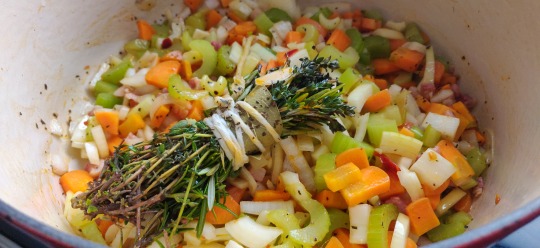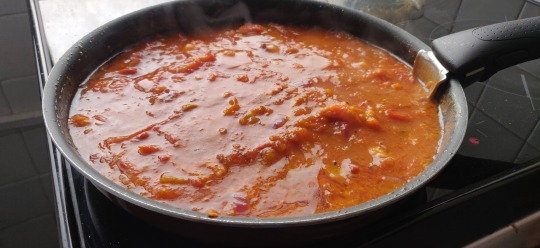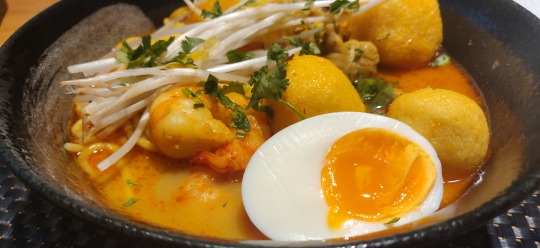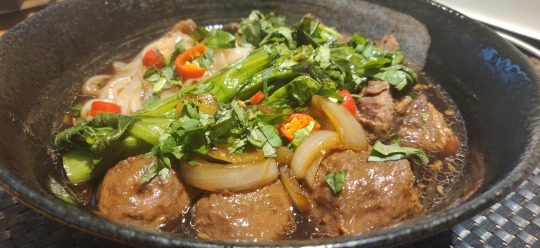#You know what also tastes good? Mayo and sweet chilli and cheese. Great with eggs and garlic bread~
Explore tagged Tumblr posts
Text
Did the most delicious thing to my toast/grilled cheese this evening… I added mayo and pizza sauce to it… so heavenly 🤤
#August is the most stressful month for VCE students and it shows I’m doing deranged things to my staple diet#You know what also tastes good? Mayo and sweet chilli and cheese. Great with eggs and garlic bread~#I love mayonnaise sm man. Essential ingredient in burgers. One of 3 ingredients in my secret dip I eat out of the bowl.#It completes ruske vejce imo too.#But yeah Dolphin you and I are diametrically opposed when it comes to food 😅#Not that you can help it. Which is why you’d always have a cute portion made to be Gentle On Stomach#I’d make one especially for you :). I live with the satisfaction that I’ll always have a bowl of creamy pesto chicken to myself >:3#Such benefits outweigh the time and complexity cost in my eyes :D#just pav things
4 notes
·
View notes
Text
How to Stock Your Pantry for the Semi-Apocalypse*

It’s been a rough couple of weeks for many of my friends in the United States, what with the pestilence, the lack of leadership, the hoarding in the supermarkets, and it’s not even the post-Apocalyptic dystopian future we were promised.
However, what’s been slowly creeping into my Facebook feed of late are the first hints of food boredom.
Even those who can afford to order in their favorite Chinese or Mexican, those menus are getting a bit long in the tooth. What once was an “every couple of weeks” guilty pleasure of General Tsao’s chicken, “special” fried rice and a bottle of your favorite twist-off cap Shiraz has lost its charm.
Anyone who follows my Instagram account knows that nothing comes between me, food and cocktails. I’m the guy who when answering the questionnaire at a new doctor’s office warily counters the “how many alcoholic drinks do you have a week” inquiry with a defensive, “Why do you need to know?”
“I hear you like to cook?” I’m often asked when being introduced to new friends and colleagues and my go-to answer is, “Yes, but I prefer to eat.”
And that’s why I cook. I wish I could say I find cooking to be this relaxing past-time, where I spend anywhere from 15-minutes to several hours whipping up a quick pasta sauce or creating a complex Indian curry, listening to Adelle or Carly Simon—a glass of Muscadet in hand. But, no. Cooking, for me, is an ordeal and a means to an end.

Homemade beef pho broth.
But that’s doesn’t mean it can’t be somewhat enjoyable; your food doesn’t have to be predictable or monotonous. And, if you’re going to be confined to your home for three to four weeks, this is where you have to improvise, to grab the whisk by the handle and make the magic happen.
The Basics
First, if you’re entering week three of isolation and it’s time to hit the markets, let’s think smart and make sure your fridge and pantry are stocked with the vitals. If you have food allergies or adopted a lifestyle that has dietary restrictions, please, swap out as needed.
Some of you have been furloughed or lost your jobs, so this is a reasonably priced list offering staples that will last a long time and give days, if not weeks, and in some cases, months of value. Buy what you feel is necessary. As Stephen Casuto, host and creator of one of my favorite cooking shows, Not Another Cooking Show, says, “You, do you.”
“Table salt is disgusting and should only be used for rubbing into the wounds of your enemies.”
The Carbs:
Pasta — enough for at least six meals for two people with leftovers, or three meals for four people (spaghetti/linguini and some kind of tube or macaroni—rotini, fusilli. etc.)
Rice — My old standby is Jasmine rice. Prepared properly it can be used in all kinds of dishes—plain, Mexican, Spanish, Asian, Indian, Italian.
The Vegetables:
Potatoes—Technically, a carb, but, hey. Both waxy (Yuko Golds, Red Bliss or similar) and floury (Idaho, Russet or similar). Keep in a cool, dry drawer, these can last for weeks if stored properly.

Preparing the base for a Pasta Fagioli soup.
Carrots—Large ones with their greens preferred, but if the hoarders have bought all those, then freakish manicured baby carrots.
Tomatoes—firm, preferably on the vine and not quite ripe yet. Only get about four to six so you will use them and they won’t rot and go to waste. Great for sandwiches, avocado toast, chopped into an omelet.
Onions—Yellow and Red (Yellow for most of the sauteeing and cooking you’re going to do, and red for fresh salads, sandwiches, and salsas)
Garlic—Two to three decent-sized bulbs, stored with the onions and potatoes. (Remember: Warm and humid makes your garlic and onions grow into stinky house plants.)

The easy and delicious weekday sauce.
Peppers—Depending on what you love or what you can tolerate, get at least two bell peppers or Italian green peppers, maybe a handful of hot red birdseye chillis, or some habaneros. These will add color and sparkle to everything from a salad to some scrambled eggs.
Celery—I’m of two minds when it comes to celery. First, it’s a vital part of mirepoix, that magical combination of onions, carrots, and celery that’s the basis of most Western soups and stews. But, unless you’re on a rabbit diet, people tend to buy it, use less than half a bunch in one minestrone soup then end up chucking the rest away. But, hey, you’re the cook.
Herbs—Get the dried kind out of desperation: bay leaves, oregano, thyme, rosemary. But, always get fresh parsley and basil.
Dried Goods:
Flour—White, all-purpose flour and Cornmeal (making cornbread for breakfast is a simple warm treat. Everyone should be able to cook this from scratch).
Thickeners—Corn starch, potato starch; I recently discovered xanthan gum and if you’re one of those folks taken by “molecular gastronomy” or food as a science project, this is one of the weirder thickening agents on the market.

Cornbread can be made in less than an hour.
Leavening Agents—Baking soda and baking powder. (Unless you’ve decided you really love baking artisanal bread, you really don’t need yeast).
Salt—Preferably sea salt, or kosher salt. Remember different salts have different salinities, so a “pinch” of pink Himalayan salt is less salty than a similar size “pinch” of Morton’s Table Salt, which, by the way, is disgusting and should only be used for rubbing into the wounds of your enemies. So, get a salt that fits your budget, your health needs, and your personal flavor profile. I prefer sea salts, they have a richness I like and I feel I can control seasoning better.
Pepper—Black peppercorns, of course, but nothing beats having a box or container of white pepper. It’s got a completely different flavor profile than black pepper and adds a wonderful heat to everything from mashed potatoes to cream soups.
Eggs and Dairy
Milk—If you’re lactose intolerant or vegan/vegetarian you can substitute soy milk or your favorite substitute here, but not almond milk because that shit is a ripoff and is killing the planet.
Cream—You will want this for mashed potatoes and to thicken some sauces.
Butter—Always buy Kerrygold Irish Butter, salted and unsalted. It’s the best butter out there. Fight me.

Making a chicken curry from scratch
Plain Yogurt—I prefer Greek yogurt myself. It’s handy to have around and a great way to add richness to a baked item if you only have low-fat milk or to make a quick fresh fruit breakfast.
Cheese—If you must, get a bag of shredded cheddar and a bag of “parmesan”. Cheeses are personal taste, I love fatty, creamy, stinky cheeses, but, honestly, they don’t last long and they are an extravagance for many people at this time. So, get what you like, but make sure you at least have a nice chunk of quality cheddar or similar cheese around.
Eggs—A dozen, big ones. Free-range if you feel guilty.

This Singapore-style laksa is easy and quick.
A Bit of the Sweet
Sugar—Processed sugar is evil. Now that we’ve got that out of the way, always have some handy. It’s great to throw a tablespoon into a tomato-based sauce to offset the acidity. And there is nothing like a lovely stack of homemade pancakes covered in melted butter, a sprinkling of sugar and a squeeze of fresh lemon juice.
Brown Sugar—Less sweet, a little smokey and great for Asian broths that ask for processed sugar. And, it’s “good” for you because, you know, it’s not processed.
Maple Syrup—For pancakes and French Toast.
Condiments:
Ketchup—Whatever you like. Though raised on American Heinz ketchup, I prefer the British brands that tend to use a little more vinegar, but that is an acquired taste.
Mayonaise—The magical base for so many different dressings and sauces. Yes, I will sit down with a plate of french fries or steak-cut chips and a cup of mayo and just go to town on that. Also, dipping cold, boiled chicken that’s torn into strips and wrapped in chilled, crisp iceberg lettuce into mayo while drinking a dry white wine on a hot summer’s day is one of God’s little miracles.

Fried halloumi cheese on a run of the mill avocado toast makes it better.
Mustard—Go ahead, buy French’s American Mustard in a squeeze jar. I don’t judge. But, please get some good Dijon Mustard, and some English Mustard, wet or the powder, is really handy to have for extra punch.
Vinegar—Plain old white vinegar if you're on a budget, but red wine, is also good. Italian balsamic if you want to live large, but I find a bottle of Japanese rice wine vinegar is the perfect all-rounder.
Hot sauce—Tobasco and Siraccha are my go-to faves, but you know what you like.
Olive Oil—Get Extra-Virgin and plain. the EVOO is great for both cooking and for finishing dishes and for cold dressings and sauces. Plain olive oil is great for adding flavor to simple fried sauces and dishes.
Vegetable Oil—A good neutral oil is Canola. It won’t kill you.
Prepared Foods
Canned Goods—at least one can of each: chickpeas, black beans, and kidney beans. Also, a can of mushrooms and a couple of cans of diced green chillis. Two to three 24-ounce cans of Italian tomatoes, with our without basil.
Frozen vegetables—A package of corn and a package of peas. One package of mixed vegetables for making quick healthy soups.
Broths and stocks—Beef, chicken, and vegetable. Fish stock for the more adventurous. (If you haven’t had sliced potatoes slow-cooked in fish stock, I totally recommend it, simple and delicious.) I always buy low-sodium because my body is, like, you know, a temple. 🙄
Actually, always try to purchase low sodium processed foods, that gives you, the cook, more power over the seasoning of your meals.

Thai beef soup with beef balls.
Now, you’re thinking, why is this guy torturing us with pictures of beautiful, exotic home-cooked meals? Why are so many of the “basics” not as exciting as the final products?
That’s because now is the time to get what I’ll call…
The New Basics
You’ve hit the local Vons, or Trader Joe’s, Publix or Wegman’s; you’ve emptied your wallet at Whole Foods and Kroeger, now let’s get some real food. Head down to your local Asian supermarket, or your local South American/Mexican supermarket, because this is where it gets interesting.
The Carbs:
Noodles—From Japanese soba, udon and Hokkaido (ramen) noodles to the long, translucent Vietnamese and Thai rice noodles to the tightly wound, sometimes flavored Chinese noodle nests, most of these keep a long time in a dry cool place and they cook quickly offering alternative tastes and textures.
The Vegetables:
Fresh Ginger Root—it’s ugly and essential, but it can change the flavor of everything from a simple broth to a quick scrambled egg into a culinary adventure. No, don’t peel it with a spoon, that’s silly. Just use a sharp knife on the extraneous knobbly bits and then use a vegetable peeler like a normal person. Honestly, I see the YouTube chefs wrestling with a chunk of ginger and a tablespoon and I just shake my head.
Choy Sum and/or Bak Choy—Definitely hunt these down at the Asian grocer. They stay fresh longer in a good vegetable crisper in your fridge; they’re easy to clean and prepare and cook very quickly.
Chayote—A green, waxy squash that is like a more flavorful cucumber, with a great texture. Add it to all your veggie soups, or saute it with some garlic. Just handy. And keeps in the fridge for a long time.
Condiments:
Soy sauce—Get both kinds, dark soy sauce and light soy sauce. The difference isn’t the color, it’s the viscosity and the flavor. Dark soy sauce is actually somewhat sweet, unctuous and thick and adds deep rich flavors to stews, soups, and sauces. Soy sauce is a nice alternative to just seasoning with salt. Get low sodium, if dietary restrictions are in place, but you don’t really need to use too much, so, I always go with regular.
Chili Oils/Pastes—Much like the fresh peppers, this is all about personal taste. I love spicy food, but I’m not a fan of heat for heat’s sake. So, no a jalapeno margarita where I can’t taste anything or feel my lips is not a great culinary experience. Still, always have these little miracle jars handy, you control the heat by how much or how little you add to the dish you’re preparing. My three faves are traditional Chinese chili garlic sauce, Chiu Chow chili oil, and Calabrian chili oil.
Vinegar — Plain old white vinegar if you’re on a budget, but red wine, is also good. Italian balsamic if you want to live large, but I find a bottle of Japanese rice wine vinegar is the perfect all-rounder.
Fish sauce—Don’t let the name and smell deter you, a spoonful of this elixir in a soup or dressing adds a lovely saltiness and brightness.
Sesame Oil—Plain or toasted. This is for flavor only, really. You can add it to dressings, or add it to vegetable oil when sauteeing, but you can’t cook with it because it burns very quickly; that said, it gives a great depth of flavor to any dish you add it to.
Frozen Foods:
Dumplings—Either factory-made or handmade, Asian dumplings are inexpensive, delicious and easy to prepare. Beef, pork, shrimp, and vegetable or a combination of two or more fillings are always available. Korean dumplings tend to be larger. Wontons are light and mostly shrimp or shrimp and pork. If you’re lucky to have a vibrant Asian community, find the “Mom and Pop” store that makes both noodles and dumplings. Fresh dumplings are usually packed with a light dusting of corn or potato starch so they can be easily frozen.
Asian-style meatballs—OK, now these have a texture that takes a little getting used to, but they are packed with protein and flavor and cook up in seconds in a frying pan or in a soup. Pork, beef, and shrimp are the most popular. I love them and find they really make a noodle soup a quick, but truly satisfying meal.
Canned Goods:
Coconut Milk—From Indian to Thai to Malaysian cuisine, this is mother’s milk. Get a couple of cans.
Peppers—Canned chipotles. Smoked in a flavorful sauce, a little goes a long way here. But you can add these to soups and basic stews to create great depths of heat and flavor.
Okay, now this is by no means a definitive list, but it’s enough I think to give you as many options as you can once you return home and prepare for the next few weeks of personal time.
As you’ve seen, I’ve included links to some of my favorite recipes with the pictures, it’s from these recipes that I reevaluated and changed how I stock my fridge and pantry.
It’s also helped inform my cooking. Bored with cereal and toast, and fried eggs, or scrambled eggs or an omelet with bacon, one morning I created what is now my favorite, flavorful, high protein, yet not too filling breakfast; scrambled eggs and dumplings. It’s my recipe, inspired by other more traditional recipes and the food I had available at the time. It’s what Chef John from the delightful Food Wishes refers to as “that’s just you, cooking.”
The First Recipe
Ingredients:
Three eggs, room temperature, well beaten, preferably in a metal bowl with a whisk
One to two scallions or a half/third of a small yellow onion, finely chopped
One chili pepper (in this case, a Thai green chili), finely chopped.
Four to six frozen Asian dumplings depending on what type
2 Tablespoons — Vegetable oil
1 Tablespoon — Sesame oil
Chiu Chow chili oil or Sriracha
Soy Sauce
Salt
In a small saucepan bring water to a boil. In a small frying pan add your vegetable oil, the onions, and chilis and some salt and turn on the heat.
You want the onions and chilis to cook slowly and sweat, not burn or brown so keep an eye on them and keep stirring.
Now once the vegetables are cooked and the kitchen smells delicious, add a tablespoon of sesame oil into vegetables and lower the heat.
Now, the water should be at a rolling boil. Add the dumplings. I used Korean pork dumplings this morning. They only take three to five minutes to cook. You will know they are done when they float and spin freely in the water.
Now, turn up the heat of the frying pan and add in the eggs, keep stirring and cook the eggs as you like them. Take the eggs off the heat, the residual heat should finish the cooking.
Meanwhile, the dumplings should be cooked. Strain them and place them in the bottom of a bowl. Then scoop over the eggs, finish with a tablespoon or two of soy sauce and the chili sauce of your choosing.
This is a 15-minute breakfast, tops. I hope this was helpful. It’s a trying time for everyone and many of us are fortunate enough to have a roof over our heads that we can cower under. This is an opportunity for reflection, but also to make the most of your family or companions. For those of you living alone, treat yourself to a culinary feast once in a while.
I say cooking is an ordeal, but it’s also a celebration. A chance to be creative and offer comfort, if not for yourself, for the people you live with and love.
Go break an egg.
*This article is the inspiration for this blog and was previously published on Medium.
0 notes